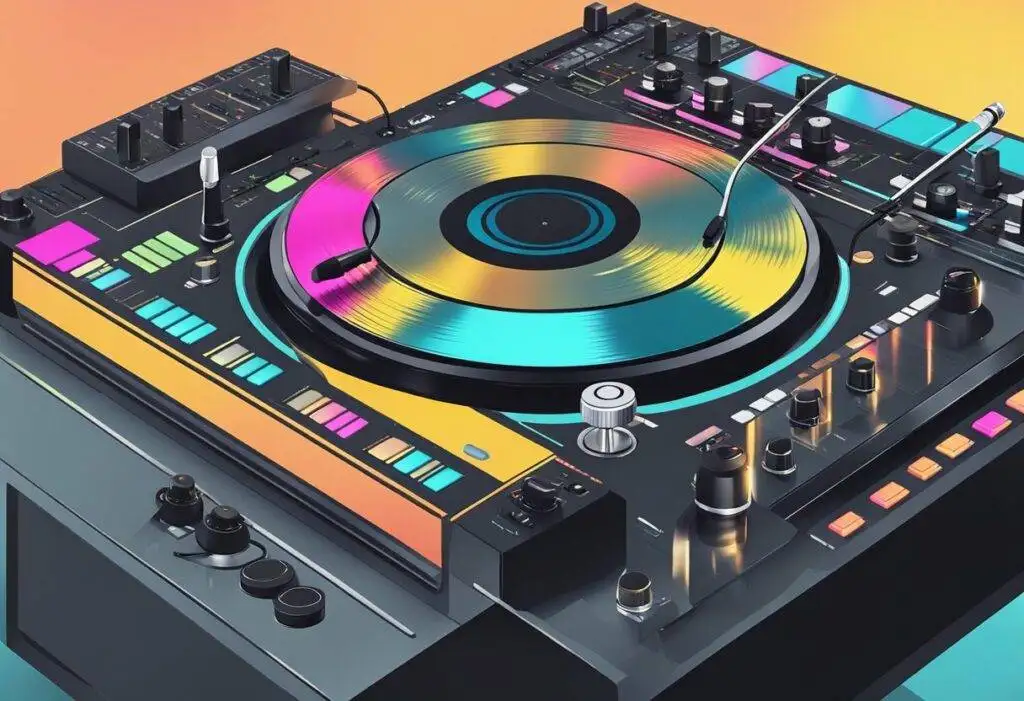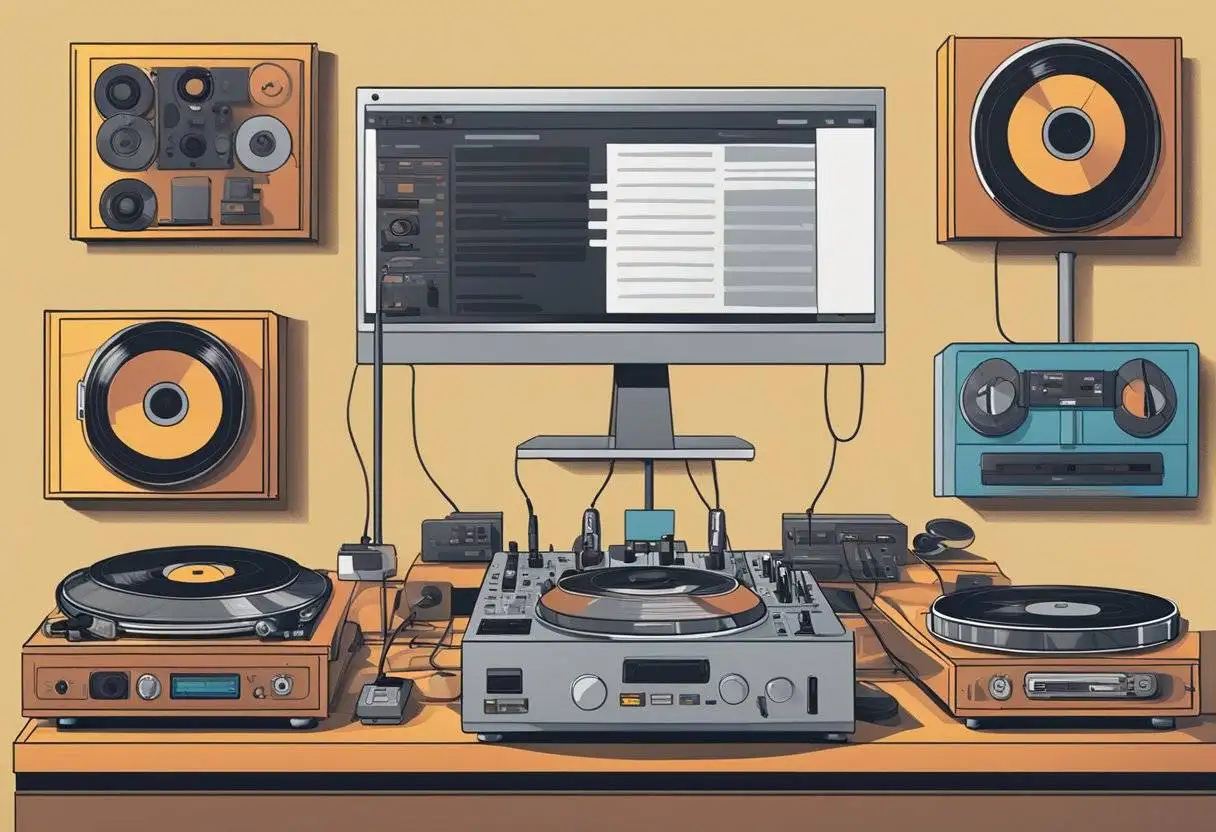As a DJ in today’s digital world, taking the craft back to its roots and performing without a laptop presents a unique set of challenges and opportunities. The art of DJing is not reliant on any single piece of technology, and you’ll find that a laptop-free setup can liberate your creativity and offer greater tactile interaction with the music. Going laptop-free means exploring hardware options such as USB decks, CDJs, turntables, and controllers that work independently or with smartphones and tablets.

Choosing to DJ without a laptop leads to discovering an array of equipment that can help streamline your performance while still providing the flexibility to mix and adapt on the fly. It’s important to understand the nuances of this approach, such as navigating music libraries without a computer screen and relying on ear and tact to cue and blend tracks seamlessly. The key to mastering this domain is familiarizing yourself with the chosen DJ equipment’s layout, features, and capabilities, and honing the essential skills of beatmatching, EQing, and effect usage.
Key Takeaways
- DJing without a laptop encourages a deeper engagement with the performance.
- Knowing your equipment inside and out is crucial for a smooth, laptop-free set.
- Skill development is central to executing a professional-sounding mix without digital aid.
Choosing the Right Equipment
In my experience, selecting the right DJ equipment is pivotal for performing without a laptop. With the right gear, you can ensure a seamless performance relying on hardware’s tactile control and potential for creative expression.
Understanding All-in-One DJ Controllers
The key to a laptop-free setup is an all-in-one DJ controller. Such controllers, like the Pioneer DJ XDJ-RX2, have built-in screens and can play music from a USB stick, eliminating the need for a computer. Products like the Numark Mixstream Pro also offer streaming capabilities from various online sources.
Alternative Hardware Options
When considering how to DJ without a laptop, classic hardware setups should not be overlooked. Traditional DJ mixers, CDJs, and vinyl turntables are all viable options. The Pioneer CDJ-3000 provides a high-resolution screen and plays from USB sources. Meanwhile, vinyl turntables offer an authentic DJing experience, requiring only your mixer and your records.
Portable Devices for DJing
For DJs on the go, using a phone or tablet with apps like Algoriddim djay allows for a portable setup. Coupled with a compatible DJ controller that works with iOS or Android devices, such as the Reloop Beatpad-2 mentioned in DJingPro article, you can manage a full set.
DJ Software Selection
While hardware is central, DJ software is also essential for those not using a laptop. I recommend Serato, Traktor, Rekordbox, and Virtual DJ as they are designed to integrate with various hardware, including controllers that do not require a computer, by keeping track of your music library on a USB port.
Audio Output Essentials
The sound output is what brings a DJ set to life. Ensuring you have a quality DJ mixer and adequate speakers is mandatory. For personal monitoring, good headphones that can clearly reproduce the mix and withstand the loud environment of a DJ booth are paramount to a successful performance.
Mastering DJ Skills without a Laptop
As someone deeply embedded in the DJ culture, I understand that the art of DJing extends beyond laptops and digital interfaces. Embracing the craft can be accomplished using traditional methods and the latest stand-alone technology that recalls the skillful era of vinyl purists.
Mixing and Scratching Techniques
Mixing and scratching are fundamental DJ skills that rely on tactile interaction with the music. I prefer to engage with my tracks directly, using DJ mixers and controllers that provide physical faders and jog wheels for a hands-on experience. Whether I’m blending tempos or creating a dynamic scratch routine, the physical feedback from hardware is irreplaceable.
- Mixing: I manually beat-match using the pitch controls and jog wheels to align the tempos of tracks.
- Scratching: With traditional turntables or controllers, I execute scratches by manipulating the platter and crossfader in unison.
Building and Managing Playlists
I prioritize playlist management to ensure smooth, captivating sets. Without a laptop, utilizing USB drives with Rekordbox software is a reliable method for preparing my music collection. The software allows me to analyze tracks, set cue points, and arrange my playlists seamlessly before a performance.
- Key actions for playlist management:
- Pre-analyze BPM and key
- Organize tracks by genre, mood, or event type
Leveraging DJ Software Features
Even without a laptop, the features of DJ apps like Serato DJ Pro or Traktor aren’t out of reach; high-end DJ equipment often includes built-in screens that offer some of the same functionalities. Looping, effects, and real-time analysis can be controlled directly from the hardware, allowing me to leverage technology without breaking the traditional DJing vibe.
- Favorite features on integrated equipment:
- Auto-looping with beat synchronization
- FX paddles that manipulate sound in real-time
Hardware Controls Familiarity
Familiarity with hardware is crucial. The layout and response of buttons, sliders, and knobs on various controllers and mixers form the basis of my tactile feedback loop. Each button and knob is mapped to specific features which allow me to perform actions quickly, like adjusting EQs or triggering samples.
Mastery keys:
- Know your controller as an extension of your hands.
- Practice regularly to build muscle memory.
Syncing Music Collections
With the integration of music streaming services like Spotify in some DJ apps and equipment, I benefit from a vast music library while DJing without a laptop. Having my playlists synced across devices ensures that I have access to my curated music collection and can respond to any crowd’s taste. This technology facilitates maintaining an extensive, versatile music library that’s always ready at my fingertips.
- Sync strategies:
- Utilize cloud storage to access my playlists anywhere
- Keep local backups on various media for redundancy
Performing Live without a Laptop
When it comes to performing live as a DJ without a laptop, understanding your setup and honing your techniques are paramount. Knowing how to engage with the audience will differentiate a good set from a great one.
Setting Up DJ Booth and Equipment
My DJ booth setup usually begins with selecting the right equipment. I avoid laptops by opting for all-in-one DJ units like the Pioneer CDJ-3000 or traditional turntables for that authentic vinyl DJ experience. These tools can ensure sound quality that rivals any laptop-based setup. It’s important to connect all elements securely, ensuring that my mixer, decks, and any other components are communicating without fail. I pre-load my music onto USB drives or use software that integrates with my equipment if I’m working with a digital vinyl system.
Live Performance Techniques
During a live performance, I prioritize a seamless mix and transition between tracks. This requires a confident mastery of my equipment’s features, whether I’m in DJ mode or manipulating vinyl records. In a club or at a party, sound adjustment is critical, so I frequently adjust levels and EQ to maintain the atmosphere. My focus is always on delivering a performance with excellent sound quality, regardless of the presence or absence of a laptop.
Engaging Your Audience
Connection with the crowd is essential. As a mobile DJ or when playing a club, it’s my job to read the room and select tracks accordingly. I make eye contact, gesture to get the crowd involved, and respond to their energy. It’s not just about the music; it’s about the experience. Engaging the audience is what takes a set from merely being heard to being felt and remembered.
Frequently Asked Questions

In this section, I’ll address some of the most common queries about DJing without a laptop. These insights should help clarify how to achieve this with the right gear and techniques.
What equipment is essential for DJing if not using a laptop?
To DJ without a laptop, you need equipment that can play and mix music independently such as CDJs, turntables, and a mixer. Some DJs choose a standalone DJ controller which combines these elements and can operate without a laptop.
Can I use a standalone DJ controller without a computer?
Yes, a standalone DJ controller, like the Pioneer DJ XDJ-RX2, functions without a computer. It has built-in screens and inputs for USB drives, which hold your music library.
What features to look for in a laptop-free DJ setup?
When choosing equipment for a laptop-free DJ setup, look for units with integrated screens, media compatibility (like USB ports for flash drives), and intuitive controls that mimic the laptop software environment.
How can you mix music with a DJ controller like the Pioneer DDJ-FLX6-GT?
To mix music on a controller like the Pioneer DDJ-FLX6-GT, load tracks onto each deck via USB or Bluetooth, use jog wheels for cueing, and employ built-in effects and transitions to fuse the tracks seamlessly.
Is it possible to DJ with analog equipment only, and how?
Absolutely, DJing with analog equipment involves using vinyl turntables and a traditional mixer. Select and cue records manually, and manipulate them by hand to blend music, an approach often preferred by purists for its tactile feel.
What are the best practices for DJing using a desktop or non-traditional devices?
The best practices include knowing your equipment inside out, organizing your music library efficiently, investing in high-quality cables and connectors, and practicing mixing with various media to become versatile in your sets, as suggested on sources like DJ Producer Tech.
